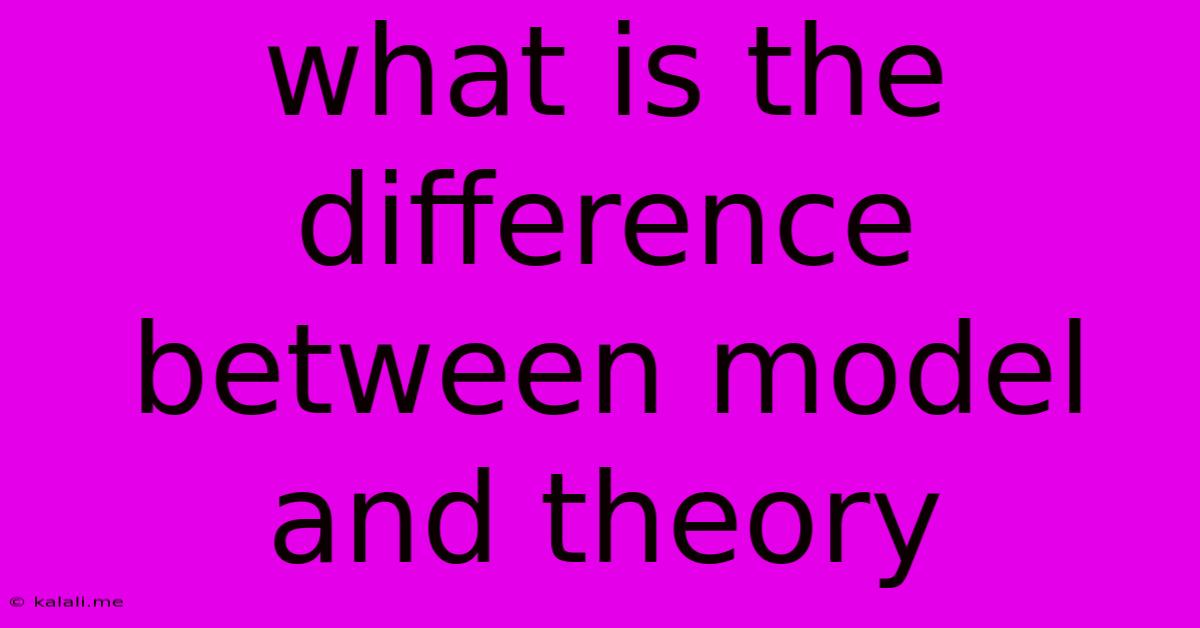What Is The Difference Between Model And Theory
Kalali
Jun 02, 2025 · 3 min read

Table of Contents
What's the Difference Between a Model and a Theory? Understanding Scientific Concepts
This article clarifies the often-confused terms "model" and "theory" in the scientific context. While frequently used interchangeably, they represent distinct but related concepts crucial for understanding scientific progress. We'll explore their definitions, key differences, and provide examples to illustrate their application in various fields.
What is a Scientific Model?
A scientific model is a simplified representation of a system, phenomenon, or process. It aims to capture the essential features of the subject matter, omitting less important details for clarity and ease of understanding. Models can take many forms, including:
- Physical models: These are tangible representations, such as a globe representing Earth or a miniature wind tunnel simulating airflow.
- Mathematical models: These use equations and formulas to describe relationships between variables, such as the equations governing planetary motion.
- Conceptual models: These are abstract representations using diagrams, flowcharts, or other visual tools, like a model illustrating the carbon cycle.
- Computer models: These use computer simulations to model complex systems, such as weather forecasting or climate change projections.
Key Characteristics of Models:
- Simplification: Models inherently simplify reality; they're not perfect replicas but useful approximations.
- Purpose-driven: Models are created to serve a specific purpose, like explaining a phenomenon or predicting future outcomes.
- Testable predictions: Good models generate testable predictions that can be verified through experimentation or observation.
- Refutable: A model should be able to be proven wrong – if its predictions consistently fail, it needs revision or replacement.
- Iterative: Models are often refined and improved based on new data and understanding.
What is a Scientific Theory?
A scientific theory is a well-substantiated explanation of some aspect of the natural world, based on a large body of evidence. Unlike the everyday use of "theory," which implies speculation or guesswork, a scientific theory is a robust explanation supported by considerable empirical evidence and rigorous testing.
Key Characteristics of Theories:
- Explanatory Power: Theories provide comprehensive explanations for a wide range of observations and phenomena.
- Predictive Power: Theories can accurately predict future events or outcomes.
- Testability: Theories generate testable hypotheses that can be verified or falsified through experimentation.
- Consistency: Theories should be consistent with existing scientific knowledge and not contradict well-established principles.
- Falsifiability: A theory must be potentially disproven; it cannot explain everything.
The Relationship Between Models and Theories:
Models and theories are closely related but serve different purposes. A model can be part of a theory, providing a specific representation of a theoretical concept. For instance, the model of the atom has evolved over time, with different models (like the Bohr model and the quantum mechanical model) reflecting our growing understanding of atomic structure. The underlying theory of atomic behavior remains, but the model used to represent it has changed.
Examples Illustrating the Difference:
-
The Theory of Evolution: This theory explains the diversity of life on Earth through natural selection. Phylogenetic trees (visual representations of evolutionary relationships) are models used to represent aspects of this theory.
-
Plate Tectonics Theory: This theory explains the movement of Earth's lithospheric plates. Maps depicting plate boundaries and directions of movement are models that visualize aspects of this theory.
In essence, models are tools used to understand and represent theories. Theories offer powerful explanations of the natural world, while models provide simplified representations that aid in comprehension, prediction, and further investigation. Both are essential components of the scientific process, contributing to our understanding and manipulation of the world around us.
Latest Posts
Latest Posts
-
What Happens If U Dont Go To Jury Duty
Jun 03, 2025
-
How Do I Test A Thermocouple
Jun 03, 2025
-
How To Get Cat Urine Out Of Wood
Jun 03, 2025
-
Can I Root A Lenovo Tablet
Jun 03, 2025
-
Can You Dump Grease Down The Drain
Jun 03, 2025
Related Post
Thank you for visiting our website which covers about What Is The Difference Between Model And Theory . We hope the information provided has been useful to you. Feel free to contact us if you have any questions or need further assistance. See you next time and don't miss to bookmark.